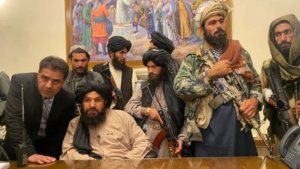An agreement that led to the Taliban’s seizure of power
 Without any significant resistance, the Taliban also occupied the capital Kabul. This occupation is the beginning of a new catastrophe for the oppressed Afghan people. For the part of the Afghan population that experienced the brutality and medieval barbarism of the Islamist Taliban years ago, their resurgence in power is terrifying.
Without any significant resistance, the Taliban also occupied the capital Kabul. This occupation is the beginning of a new catastrophe for the oppressed Afghan people. For the part of the Afghan population that experienced the brutality and medieval barbarism of the Islamist Taliban years ago, their resurgence in power is terrifying.
People keep asking why it could all happen so quickly and without resistance from the 300,000-strong Afghan army.
The answer is quite simple: it was agreed that there should be no resistance. It was decided in advance that the war was over and that the Taliban would take over. The Afghan government, as well as the military, had already been informed.
The Taliban were seen as an alternative for the takeover of political power by U.S. imperialism and its ally after U.S. expansion plans for the Middle East failed due to increased casualties and rising costs. Therefore, the U.S. government decided to withdraw its troops from Afghanistan. One of the reasons for this decision was the political assessment that the Taliban have influence and base among the Pashtun population, who make up almost half of the Afghan population. Nor can their methods of waging war be easily countered.
The Taliban once rose to power through financial and logistical support from U.S. imperialism and regional reactionary governments such as Pakistan, Saudi Arabia, and the United Arab Emirates. It proclaimed the Islamic Emirate of Afghanistan and was later overthrown by U.S. military forces in 2001.
The U.S. government’s renewed turn toward the Taliban began during Barack Obama’s tenure. Indirect negotiations took place. In 2013, the U.S. established a representative political office for the Taliban in Qatar. Since then, Taliban political activities have increased, and they received political, financial, and military support from other states. Informal negotiations between the United States and the Taliban continued through 2018.
In October 2018, as the U.S. State Department’s special envoy for Afghanistan, Khalilzad began formal so-called peace talks with Taliban representatives. After 11 rounds of negotiations and secret agreements, a meeting with 30 government delegations, including the U.S. secretary of state and Germany’s special representative to the European Union, was held in Doha on Feb. 29, 2020. Here an agreement was signed between the USA and the Taliban as representatives of the “Islamic Emirate of Afghanistan”. The still official government played no role in this and was not invited to the negotiations. Although the impression of inter-Afghan negotiations was given, the handover of power to the Taliban had already been officially decided.
The agreement provided, among other things, that prisons in Afghanistan would release some 5,000 Taliban prisoners.
It was agreed that “the United States, its allies, and the Coalition will complete the withdrawal of all remaining forces from Afghanistan within the remaining nine and a half months.”
It was agreed that “the United States, its allies, and the Coalition will withdraw all their forces from the remaining bases.”
No force will be used against Afghanistan’s territorial integrity or political independence, and there will be no interference in the country’s internal affairs. Sanctions against Taliban members were also lifted.
For its part, the Islamic Emirate of Afghanistan assured that it will not allow any of its members, other individuals or groups, including Al-Qaeda, to use Afghan territory to threaten the security of the United States and its allies. There will also be no cooperation with these individuals or groups.
The Islamic Emirate of Afghanistan will not issue visas, passports, travel permits, or other legal documents to individuals who enter Afghanistan and threaten the security of the United States and its allies.
It is clear from these provisions of the agreement that the conflict is over, and Afghanistan’s surrender from the Islamist Taliban has been confirmed.
The surrender agreement was also welcomed and endorsed by Afghan government officials and other official figures and hailed as the beginning of a process to end the 40-year war.
Thus, it is clear why the Afghan army did not resist the Taliban attacks. It was clear to all that the U.S. government had agreed to the Taliban takeover under the Doha Accord. The Afghan military no longer saw any reason or incentive to resist and fight.
The question now is whether the Taliban can smoothly establish its Islamic emirate? Undoubtedly, the Taliban has not changed in the least, even if a different impression is being worked on. Over the past twenty years, changes have taken place in Afghanistan that seriously hinder Taliban goals.
A different consciousness exists in Afghan society. Afghan youth have adopted a different lifestyle over the past twenty years and are more connected to the outside world, including new means of communication. They will not readily submit to the ideas and goals of the reactionary Islamists.
Women, in particular, are resisting to preserve their gains. Today, the Taliban are opposed by millions of people who resist oppression and the medieval notions of the Taliban.
Moreover, the Taliban are unwilling to share political power with other rival groups. The very name Islamic Emirate of Afghanistan is incompatible with other groups sharing power, despite their influence in Afghanistan.
The Taliban will still tolerate these political rivals in the short term to strengthen its position at home and gain international approval and support.
There is much to suggest a new round of civil war in Afghanistan. The Taliban’s seizure of power represents a new crises in Afghan society that will soon become apparent.


